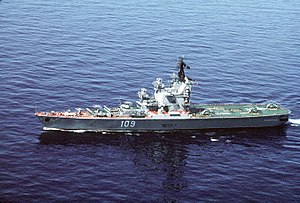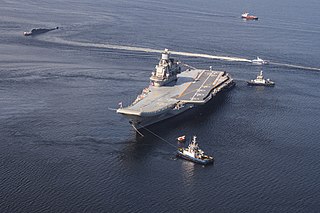
The Kuznetsov-class aircraft carrier, Soviet designation Project 11435, is a class of fixed-wing aircraft carriers operated by the Russian and Chinese navies. Originally designed for the Soviet Navy, the Kuznetsov-class ships use a ski-jump to launch high-performance conventional aircraft in a STOBAR configuration. The design represented a major advance in Soviet fleet aviation over the Kiev-class carriers, which could only launch VSTOL aircraft. The Soviet Union's classification for the class was as a heavy aircraft-carrying cruiser, which permits the ships to transit the Turkish Straits without violating the Montreux Convention, however the Chinese variants are classified as aircraft carriers.

The Kirov class, Soviet designation Project 1144 Orlan, is a class of nuclear-powered guided missile cruisers of the Soviet Navy and Russian Navy, the largest and heaviest surface combatant warships in operation in the world. Among modern warships, they are second in size only to large aircraft carriers, and of similar size to a World War I era battleship. The Soviet classification of the ship-type is "heavy nuclear-powered guided missile cruiser". The ships are often referred to as battlecruisers by Western defence commentators due to their size and general appearance.

The 46 Knox-class frigates were the largest, last, and most numerous of the US Navy's second-generation anti-submarine warfare (ASW) escorts. Originally laid down as ocean escorts, they were all redesignated as frigates on 30 June 1975, in the 1975 ship reclassification plan and their hull designation changed from 'DE' to 'FF'. The Knox class was the Navy's last destroyer-type design with a steam turbine powerplant.

USS Leahy (DLG/CG-16) was the lead ship of a new class of destroyer leaders in the United States Navy. Named for Fleet Admiral William D. Leahy, she was commissioned on 4 August 1962 as DLG-16, a guided missile frigate, and reclassified as CG-16, a guided missile cruiser, on 30 June 1975.

The Soviet Navy was the naval warfare uniform service branch of the Soviet Armed Forces. Often referred to as the Red Fleet, the Soviet Navy made up a large part of the Soviet Union's strategic planning in the event of a conflict with the opposing superpower, the United States, during the cold war period between the two countries. The Soviet Navy played a large role during the Cold War (1945-1991), either confronting the North Atlantic Treaty Organisation in western Europe or power projection to maintain its sphere of influence in eastern Europe.

An anti-submarine warfare carrier is a type of small aircraft carrier whose primary role is as the nucleus of an anti-submarine warfare hunter-killer group. This type of ship came into existence during the Cold War as a development of the escort carriers used in the ASW role in the North Atlantic during World War II.

The Kiev class, Soviet designation Project 1143 Krechyet (gyrfalcon), was the first class of both fixed-wing aircraft carriers and battlecruisers built in the Soviet Union for the Soviet Navy.

Moskva was the first of her class of helicopter carriers in service with the Soviet Navy. Laid down at Nikolayev South, Moskva was launched in 1965 and she was commissioned two years later. Moskva was followed by Leningrad, which was commissioned in late 1968; there were no further vessels built, reportedly due to the poor handling of the ships in rough seas. Both were conventionally powered.

The Moskva class, Soviet designation Project 1123 Kondor (condor) and S-703Project 1123M Kiev, was the first class of operational aircraft carriers built by the Soviet Union for the Soviet Navy.
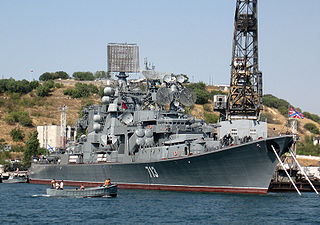
The Kara class, Soviet designation Project 1134B Berkut B, was a class of guided missile cruisers built in the Soviet Union for the Soviet Navy. The NATO lists the class as "cruisers" mainly due to the Metel anti-ship missile system capable of striking not only submarines, but also surface vessels.

The People's Liberation Army Navy Surface Force is the surface warfare branch of China's People's Liberation Army Navy (PLAN), consisting of all surface vessels in operational service with the PLAN. The PLAN Surface Force operates 661 ships organized into three fleets: the North Sea Fleet, the East Sea Fleet and the South Sea Fleet.

The Albany-class guided missile cruisers were converted Baltimore and Oregon City-class heavy cruisers of the United States Navy. All original superstructure and weapons were removed and replaced under project SCB 172. The converted ships had new very high superstructures and relied heavily on aluminum to save weight.

USS Carpenter (DD/DDK/DDE-825) was a Gearing-class destroyer of the United States Navy, named for Lieutenant Commander Donald M. Carpenter (1894–1940).

The Kildin-class destroyer was a series of destroyers built for the Soviet Navy in the 1950s. They were a missile armed version of the Kotlin-class destroyer, and the class was named for Kildin Island. Four ships were built around the KSShch anti-ship missile. When this missile became obsolete in the 1960s, three ships were modernised in 1972-1977. All ships were decommissioned in the late 1980s early 1990s. The Soviet designation was Project 56EM for the prototype (Bedovy), Project 56M for three series ships, and Project 56U for the modernised ships.
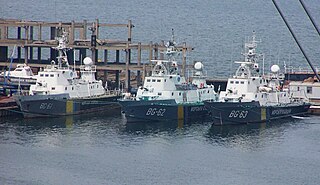
The Stenka class is the NATO reporting name for a class of patrol boats built for the Soviet Navy and Soviet Allies. The Soviet designation was Project 205P Tarantul. The boats are an anti-submarine (ASW) patrol boat version of the Osa-class missile boat.

Marshal Voroshilov was a Project 1134A Berkut A class cruiser of the Soviet Navy, which briefly became part of the Russian Navy after being renamed Khabarovsk in 1991. The fifth ship of her class, the ship served mostly during the Cold War, from 1973 to 1992.

Admiral Oktyabrsky was a Project 1134A Berkut A -class cruiser of the Soviet Navy, which briefly became part of the Russian Navy. The sixth ship of her class, the ship served mostly during the Cold War, from 1973 to 1993.
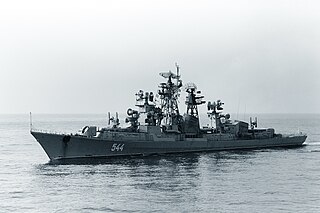
Sposobny was a Project 61 destroyer of the Soviet Navy, which briefly became part of the Russian Navy. The ship served during the Cold War from 1971 to 1989.

Admiral Isachenkov was a Project 1134A Berkut A -class Large Anti-submarine Ship of the Soviet Navy. The seventh ship of the class, the vessel was launched in 1972 and served during the Cold War with the Northern Fleet, often operating in the Atlantic Ocean but also travelling to various ports in the Mediterranean Sea. The ship acted as flagship for the Minister of Defence, Marshal of the Soviet Union Andrei Grechko, during Okean-75 in 1975 and operated alongside the newly launched Project 1143 Krechyet aircraft carrier Kiev in 1977 and 1978. The ship also shadowed the NATO aircraft carriers HMS Ark Royal, USS Independence and USS John F. Kennedy. The cruiser was taken out of service for repairs in 1981 and substantially upgraded with new weapons and communications systems, re-entering service in 1982. With the end of the Cold War, the Navy reassessed its need for large warships and, after a career stretching nearly twenty years, Admiral Isachenkov was decommissioned in 1992 and sold to be broken up.

Petropavlovsk was the fifth ship of the Kara-class cruisers of the Soviet Navy. She was launched in November 1975 and commissioned in December 1976 at the 61 Communards Shipyard. In 1996, she was scrapped in India.
